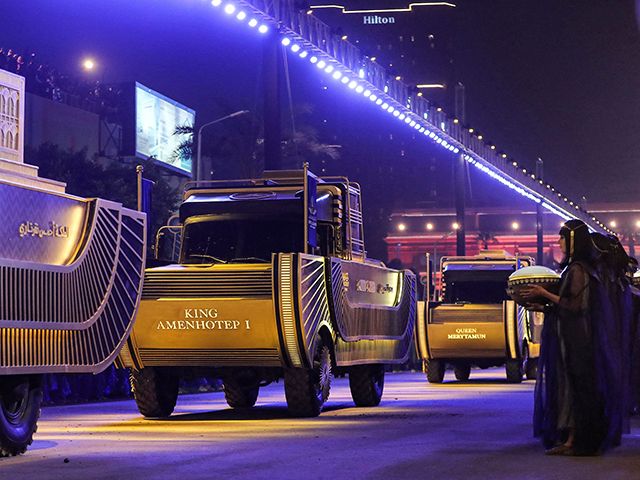Egypt staged an elaborate procession on Saturday to celebrate the transport of 22 of its ancient royal mummies from a historic museum in central Cairo to a newly built facility in the national capital.
The Pharaohs’ Golden Parade moved from the Egyptian Museum in Cairo’s main Tahrir Square to the newly constructed National Museum of Egyptian Civilization located four miles south. Golden trucks decorated in pharaonic designs transported the mummies to their new resting place via climate-controlled cases.
“The vehicles were designed to appear like the ancient boats used to carry deceased pharaohs to their tombs,” according to the Associated Press (AP).
Most of the mummies date to ancient Egypt’s New Kingdom, which ruled from 1539 B.C. to 1075 B.C., according to Egypt’s Ministry of Antiquities. The parade transported 18 kings and four queens in chronological order of their rule. The procession included some of ancient Egypt’s most famous leaders, such as Ramses II, who ruled for 67 years, and Queen Hatshepsut, Egypt’s only female pharaoh.
Cairo authorities shut down several streets and intersections in the capital to accommodate the event, which included a gala in Tahrir Square where representatives of 400 international press agencies gathered in bleachers to document the spectacle. Egyptian President Abdel Fattah al-Sisi joined other Egyptian dignitaries in Tahrir Square to watch the parade before welcoming the mummies as they arrived at the National Museum of Egyptian Civilization. The president’s welcoming ceremony served as an inauguration of the new museum, which has only displayed partial exhibits since it was built in 2017. Twenty of the mummies will go on display to the general public starting April 18, while two others will be stored.
“This majestic scene is a new evidence of the greatness of this people, the guarding of this unique civilization that extends into the depths of history,” Al-Sisi wrote in a Twitter statement.
The Egyptian government spent millions of dollars organizing the Pharaohs’ Golden Parade as a way to encourage international tourism to Egypt. The country relies heavily upon the tourism industry for revenue and has suffered great economic losses in the sector due to the ongoing Chinese coronavirus pandemic. Prior to the pandemic, a 2011 popular uprising caused years of political turmoil for Egypt and discouraged tourists from visiting the country.
The movement of the mummies from their decades-long resting place at Cairo’s old museum has caused some observers to speculate that the disturbance may have unleashed a so-called “curse of the pharaohs” on Egypt, which has suffered a string of bad luck in the weeks since the Pharaohs’ Golden Parade was announced.
Dozens of people died when two passenger trains collided in Sohag, Upper Egypt, on March 26, and at least 18 people died when an apartment building collapsed in Cairo the next day.
“Then, as preparations were in full swing to move the mummies to their new resting place, the Suez Canal was blocked by the giant container ship the Ever Given, for almost a week,” the AP noted on Sunday. Egypt suffered an estimated $1 billion loss from the nearly weeklong blockage, which took place from March 23-29.
The “curse of the pharaohs” dates to the 1922 discovery of King Tutankhamun’s tomb, when a warning inscription reading “Death will come on quick wings for those who disturb the king’s peace” was also allegedly unearthed alongside the teenage ruler’s sarcophagus. The myth of the pharaohs’ curse has survived over the past century, despite a lack of evidence that this warning inscription exists.

COMMENTS
Please let us know if you're having issues with commenting.